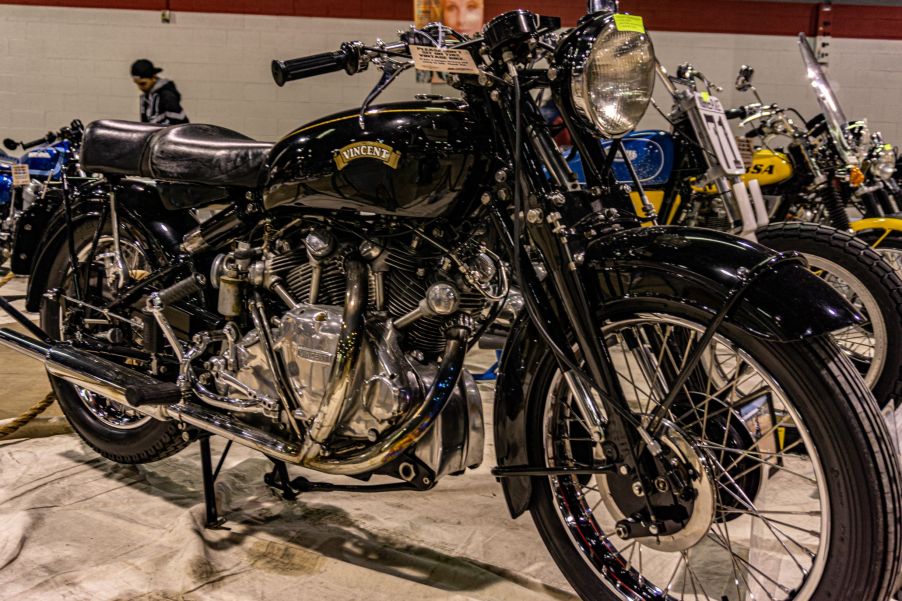
The Vincent Black Shadow Was the Real First Superbike
Long before the Hayabusa, riders turned to British motorcycles for speed and new technology. In the 20s, the Brough-Superior SS100 went faster than many cars. And in the 60s, café racers roamed the streets trying to do ‘the ton.’ The 70s, though, saw the rise of Japanese bikes, beginning with the Honda CB750, often considered the world’s first superbike. But while the CB750 may have inspired the term, the earlier Vincent Black Shadow arguably deserves the title more.
The Vincent Black Shadow’s backstory
The Vincent Black Shadow’s, or rather, the Vincent HRD Black Shadow’s story begins with failure, Cycle World explains. In the 1920s, Phillip Vincent liked racing BSA bikes, but they kept breaking. He wanted to make his own bike, and to do so, he purchased the defunct HRD motorcycle company in 1928, Silodrome reports.
In its early days, Vincent HRD used single-cylinder JAP engines. However, in 1934, after multiple engine failures in the Isle of Man TT, Vincent hired Australian engineer Phil Irving. Together, they created the company’s first V-twin bike, the 1936 Vincent Rapide Series A. Which, after WWII, evolved into the radically unconventional Rapide Series B, Bonhams reports.

With the Series B came the 1948 Black Shadow, Bonhams reports. And it almost immediately entered itself into the record books.
What makes the Vincent Black Shadow a superbike?
The ‘base’ Series B Rapide was already the fastest production bike in the world, Bonhams reports, capable of 110 mph in 1946. But the Black Shadow, with its 55-hp 998cc V-twin, bumped that up to 125 mph, Hagerty reports. That record wouldn’t be broken until 1973 when the debut of the 132-mph Kawasaki Z1.

At the time, the fastest car in the world was the Jaguar XK120, which could only do 120 mph. Plus, unlike some other bikes at the time, the Vincent Black Shadow could reliably and calmly maintain 100 mph, Cycle World reports.
But it wasn’t just sheer speed which made the Vincent Black Shadow a superbike, RideApart reports. For its time, it was an incredibly advanced machine. It has a cantilever rear suspension system—which Vincent originally developed in the 1920s—not unlike modern swingarms. Also, the engine and transmission are stressed members, eliminating the need for conventional frame down tubes. The levers, footpegs, pedals, even the seat height are all adjustable, Classic Driver reports. The rear fender is hinged upward, to make removing the rear wheel easier.
As a result of all this, Motorcyclist reports, the Vincent Black Shadow rides like a significantly more-modern motorcycle. And it only weighs 460 pounds. The only limitations are the drum brakes.
The Vincent Black Shadow famously features a 5”-diameter 150-mph speedometer. And that’s thanks to the Vincent Black Lightning, Hagerty reports. It weighs 85 pounds less than the Black Shadow, but has 15 more horsepower, Silodrome reports. Do you know that famous photo of the bathing-suit-clad rider seemingly hanging on for dear life? That’s Rollie Free, setting a 150-mph world speed record at the Bonneville Salt Flats on his Vincent Black Lightning.
Getting one today

Vincent closed its doors in 1955, after producing Series C and Series D Rapide and Black Shadow models. Of the 6,852 V-twin bikes it produced, 1774 are Black Shadows, and 30 are Black Lightnings. Vincent also made 15 ‘White Shadows,’ which are Black Shadows with polished chrome fuel tanks.

Due to their rarity and historical significance, the Black Lightning is an incredibly valuable antique bike. In 2018, a 1952 example sold for $929,000 at a Bonhams auction. It’s still the most expensive motorcycle ever sold at auction.

In contrast, while a Black Shadow isn’t exactly cheap, it’s significantly more affordable. As of this writing, a 1953 Series C model is listed on Bring a Trailer for $60,000. And even pristine ones rarely go for more than $100,000.
True, that could almost buy you one of Aston-Martin’s superbikes. But how many 70-year-old bikes can keep up with modern traffic?
Follow more updates from MotorBiscuit on our Facebook page.


